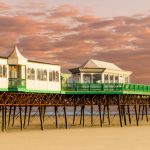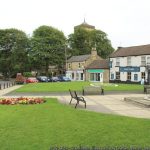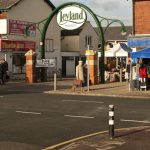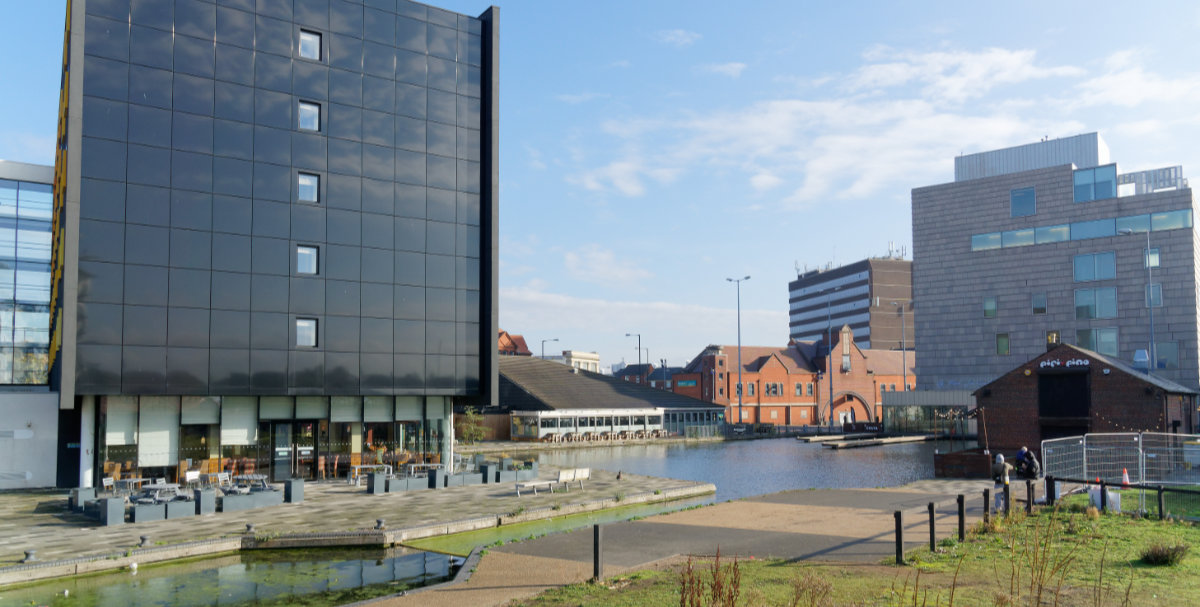
A Five Minute Walk Round Walsall
Somewhere in Staffordshire lies Walsall, former Manor Estate and now a jewel in the West Midlands crown.
Although the settlement of this area dates away, way back to the earliest days of British inhabitancy, Walsall still hasn’t made city status yet. We had to find out why, after more than a thousand years, this larger than life town isn’t the capital of the country yet…
Without further ado, here is the Five Minutes Spare walk around Walsall. We do so hope you enjoy it.
Early Walsall
In exactly 1002, documents refer to this town as Walesho. It is thought that this means ‘the Valley of the Welsh speakers’ and refers to the early Brythons. These were the people who inhabited the ‘Celtic’ lands. The origins of the word ‘Celtic’ actually being a word that originated in the deep south of England and referred to everyone in Britain that wasn’t English.
If you are interested in the origins of the ‘Celtic’ people then you should read this article over on Irish Central. The Celts included the Scots, the Irish, the Welsh, some Spanish tribes, and anyone from the northwestern reaches of Europe.
Other theories about the name of the town come from around the 5th and 6th centuries. At one point, the Anglo-Saxons had a town here. The name might have come from a warlord named Walla, and be his town, as it were. We much prefer this version. Walla wasn’t that unpopular a name… it could happen.
The Doomsday Book
Come 1086 there is no mention of Walsall in the Domesday Survey. It is thought that this is because a manor, belonging to one William Fitzansculf. William was a Norman who was granted lands in the English countryside after the death of his father, who came over with William the conqueror. They had manors in Birmingham, in Dudley, in Selly Oak… basically all over England.
He was a powerful man. According to Domesday recordings William owned more than a hundred estates so it was highly unlikely that he spent much time at Walsall. He died laying siege to a castle during the First Crusade… because of all the things he really needed in life, yet another castle was something worth dying for.
Anyway, by the 13th century, Walsall was seeing a weekly market and an annual fair. This meant it was displaying classic signs of becoming an important market town. The fair was so successful that in 1339 a second fair was added. In those days, a fair would last anything up to a fortnight and traders would come from anywhere within two or three days of horse-drawn travel.
Walsall gets its Mayor
It took another full century before the town got a mayor of its own, conclusively proving that people were once capable of handling things without being governed. By the end of the 14th-century coal mining was the main industry. Around this time, farming started to take a back seat as the main work in the area. Instead, ironstone was brought out of mines and metalworking was of great importance. By the start of the 1500s, it is thought the population would have been around 1500 or so[i].
The town was still known as Walshale in the 17th century, but for the majority of the 16th, it was a slow-growing town where metalworkers thrived. Pots, pans, tools and in particular, bits for horses and keeping animals were made in Walsall. Halfway through the century, a school was opened in the area. Queen Elizabeth, I visited around that time, leading the school to use the Queen’s official emblem of the rose as their own. Later, Charles I’s wife and Queen Consort Henrietta Maria also spend a night in Walsall in 1643. In those days, the railway hadn’t been invented yet. If it had, the visits from two queens would have seen the population flock to Walsall as it did in other English towns (like Southend) but unfortunately this was not the case.
Walsall remained mostly stagnant population-wise up until the Industrial Revolution. It would have had a population of about 2k at the start of the 18th century. Needless to say, it didn’t take long to expand…
Fun Facts about Walsall
We interrupt this historical rendition to bring you some light-hearted humour. Here are the Five Minutes Spare favourite fun facts about Walsall… according to the locals.
- The arboretum has a Blackpool style illumination all of its very own. They are more aptly called the ‘Walsall illuminations’ locally and are a favourite place to see.
- Walsall is the current centre of the English leatherworking industry. We will cover how it came to be that in a little while. The queen has worn leather handbags from Walsall! It started with the horse’s bits and metalworking and grew beyond belief.
- Lime was once extracted here. The Rushall Lime Pits nearby are now filled with water and sport more than 300 types of wildflower[ii]. It’s a lovely place to stroll but remember some sugar water for the bees.
- Walsall is part of the ‘Black Country’ that is named so for a few reasons. It has black soil, mainly because it sits on a huge coal streak, and it was disastrously affected by the black death. Some areas saw as much as 100% mortality rates… and we think we have it bad.
- According to Birmingham Live, this means the Black country includes Blackheath, Bilston, Dudley, Cradley Heath, Halesowen (but not all of it), Oldbury, Old Hill, Tipton, Walsall, Wednesbury and West Bromwich, specifically.
See? Walsall isn’t just serious history, it’s fun and games, too. Now let’s get back to the serious stuff… What was Walsall like in the Industrial Revolution and how did it reach the 70k (ish) numbers that it houses today?
The Industrial Revolution Reaches Walsall
In 1801 the population was a little over 10,000. This was a bit of a jump from the 17th century and we can only attribute this to the metallurgy industry that was growing up from the coal and iron mines. In 1803 a theatre opened, establishing the town as an important place – at least important enough to require entertainment for the locals.
As the coal, iron, and even leather industries kicked off in the area, so too did the town. Rapid expansion in the following few years was due to the manufacturing of saddles for horses, chains, buckles and plated goods. The limestone quarry was opened and dug out, the one that is now a nature reserve. Where the water is now was once a lime pit, where workers would have chipped out the semi-dangerous silica with pickaxes.
As of 1824/5 the town received permission to light, clean and pave the streets. A gasworks opened to help them establish gas lamp lighting. 11 alms houses – workhouses for the poor – were opened for women and came to be referred to as the Molesey Alms-houses. They were contributed by Blanch Wollaston, who left a house for the poor and 10s from the Barr income for poor women in the town. It’s actually very humbling to think that even back then, in the 18th century, women were taking care of one another.
More streets were added until cholera and smallpox broke out in town. After this, somewhere around the middle of the 19th century, sewers were added, and piped water became a thing. Also, people realised they should be washing more often. Particularly washing their hands… Something we, as a people, need reminded of in 2020.
1847 saw the arrival of the great railway and, by 1901, the population was 86 thousand people… a huge leap. By this time a library, hospital, trams, art gallery, museum, and a cemetery had all grown around the busy town. Let’s be clear: at the height of the Industrial Revolution, Walsall was larger in residential numbers than it is right now.
Modern Times… Or at least the last Century
The start of the 20th century saw electric lighting in the streets, the trams electrified, and booming, thriving metalworking industry in the town. Leatherworkers abounded, growing alongside the iron foundries. Craftsmen flocked to the town and the people experienced a sort of cultural revolution as a wave of famous people were born here. Leather clothing became popular, as well as horse saddles…
There were so many industries in Walsall at this point that it earned the nickname of the ‘town with a hundred trades. This might seem like a bad thing to an inexperienced eye, but it’s not. Economically, no one industry dominated. This is probably why the town didn’t lose as much population as other places did after the Industrial years ended.
At the beginning of the 20th century, Walsall had gained international notoriety as the leatherworking capital of the world. In the 1920s the government rolled out council housing across the country for the first time ever, in a bid to ease up the slums the Revolution of industry had created. After 1945, many more council houses were added. Shopping centres, gardens and museums opened after the war… but Walsall did not come away completely unscathed.
WW2 Walsall
During WWII Walsall was recognised as a centre of important manufacturing. As such, it was often bombed. One account tells us that a bomber hit the gas works at one point, but the bomb did not explode. Luckily, we suppose, the bomb landed on the gasometer, which went up in flames. Many of the wartime homes still have cellars dug out for protection from the bombs.
Although Walsall was bombed during the war, it was nothing compared to what they suffered in nearby Birmingham. With such a large target nearby it seems that most of the heat was drawn away from Walsall. Another account of the bombings in Walsall talks about a bomb landing in the Arboretum lake… rather comically adding that it took 15 years to get the ducks to return after that. If only the war was as easy-going for everyone else…
Since the wars, Walsall has gone from strength to strength. Some of the population have gone on to bigger pastures, but the majority stayed, settled, and had children. Walsall has seen new streets, new governance, and new shops, industries, and residential areas added in the last 70 years or so. However, one thing has remained constant. To this very day, Walsall remains the leatherworking capital of the world… and that is a title to be proud of.
Famous people that Come from Walsall
Given that this town has been around since Anglo-Saxon times, it only seems fair that there should be a few hundred famous Walsall faces. We took a look to source the Five Minutes Spare favourite famous faces out of Walsall. Enjoy!
- John Byrne, a comic artist for DC and who has a huge collection in his own right, was born in Walsall.
- Rachel Unitt, the footballer for the London Bees, was born in Walsall.
- Mark Lloyd – the boxer – was born here.
- The guitarist from Slade, which not everyone remembers nowadays, was born in Walsall, his name is Neville Holder.
- Ellie Simmonds, English Paralympic athlete who competes as a swimmer.
- The DJ Goldie (the one with the weird pointed teeth) is from Walsall[iii].
So there are a fair few famous faces that come from this seemingly sleepy little town. Now that we have covered the famous faces, history, and fun facts, it is time to move on to the attractions… If you were taking a holiday in Walsall, what would be the sights you ought to see?
Attractions in Walsall
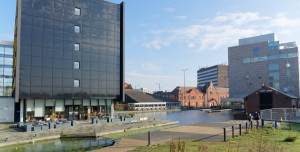
Image: LLYOU Grzegorz Wasowicz/Shutterstock.com
There are tons of fun things to do in Walsall for an afternoon. Let’s look at the best the town has to offer in terms of attractions…
Museums and Art Galleries
Top of the list of things that you need to do when you come here (it’s almost obligatory) is to visit the Leather Museum. It sounds like it is about as exciting as a library visit but it is one of the top attractions in town. The kids love it, they have a café, and you learn all there is to know about the industry through the Walsall ages.
A second museum that is worth its weight in golden car parts is the Aston Manor Road Transport Museum. This place has a lovingly preserved classical car collection that any true petrolhead will love. You will find it in nearby Aldridge.
For art galleries, the New Art Gallery is that oddly shaped, pale building in central Walsall. It cost around £21 million to design and build. Art isn’t cheap. Totally worth it though. Have a visit and see for yourself. They are having their 20th anniversary year this year (2020) so there will be plenty of opportunities for fun.
Outdoor and Recreation
Another favourite attraction in Walsall is the Arboretum park. We mentioned this briefly before because it has the most wonderful illuminations at night. Reviewers and locals think that they might be better than the ones you get at Blackpool… but we will let you decide for yourself.
The Bourne Pool and Waterside Walk is a lovely way to spend an hour in nature. Keep the kiddies supervised around the water and pick a sunny day for it. The pond is beautiful and well worth the walk. For another park to relax in, check out the Willenhall Memorial Park. It’s always nice to pay your respects. This particular park was built just after WWII and for obvious reasons.
Sports!
Walsall is the home of Banks’s Stadium where you can visit and take a tour. You can even catch a match there most weekends or see the team training. It was built in 1989-90 and is the home to Walsall Football Club. Fans can find it on Bescot Crescent but, let’s be honest about this, it’s hard to miss those floodlights.
Retail
The Saddlers Shopping Centre is named as one of the best in town but you have plenty of options for good shopping. You can also find the Crown Wharf Shopping Park to be filled with customers on any given day. You are bound to find what you are looking for between the two places.
Historic Sights and Landmarks
The Walsall Arena and Arts Centre is becoming a landmark, even if it is a thoroughly modern one. You can also take the trip in to Birmingham and visit the house and gardens at Soho House. They give guided tours that get top marks.
If you are in the area, and you are interested in learning about where you are staying, pop into the Pelsall History Centre. It will help you to understand the culture, the people, and the relaxed attitude you will find in this part of the country.
Other Notable attractions
If you are stopping in Walsall for any length of time and need more inspiration about what to do, here are some of the attractions we just couldn’t fit into one article:
- The Bloxwich Active Living Centre – Looking for something to do in Walsall with kids? Try the Active Living centre. There is a gym, a swimming pool, and some indoor courts you can use.
- Visit the go-Karting track – Walsall has its very own go-karting centre, which is tremendous fun and great for team building days.
- Visit Walsall Central Library… This one isn’t boring!
When you visit Walsall there is always something that will suit you.
Where to Eat, Drink, and Party in Walsall?
If regular but yummy pub grub is what you are after, you will find it at the Queen’s Head. You will also get a decent pint there, if that’s what you like. If you want somewhere slightly fancier to eat, Chiquito offers a semi-Mexican, semi-American menu that’s a nice fusion mix.
Looking for a nice café to pass an hour in? Simply Delicious are a local favourite. If you have a car or transport to hand, head out to West Bromwich and try the Turkish menu at the Turquoise Kitchen and Bar. It gets nearly top marks from every single reviewer!
When it comes to having a night out on the town, there are several options. The best cocktails can be had at the Dream Blue Shisha Lounge… Bar NV is the best pub to pass time in style… it’s the only champagne bar in the town. If you want to dance the night away though, you need a club.
There’s Coliseum but that’s the wrong type of club… also the spelling makes us flinch a little. The Suede Bar and Night Club is much more tasteful, but you can also have a good, old-fashioned drink-n-dance at Religion, where there is always a DJ waiting.
As you can see, Walsall has an active nightlife scene. Get out there, have some fun, and double-check it’s not a lap dancing club before you go. Unless that’s your thing. No judgement here, let’s just move on.
How to Get there?
We can talk history, attractions, and where to eat in Walsall all day long… but if you don’t know how to get there, there’s really no point.
By Road
Walsall is on the M5 if you are coming from the South. If you are coming from the west then head out of Shrewsbury on the M54. Coming from the north? You need the M6… You can head north on the M1 out of London, too, and then head East when you see signs for Coventry.
By Rail
Head for Walsall Railway Station. If travelling from London and you don’t pass through it, head to Birmingham. You will be able to get a train from there.
By Air
Again, if you are flying to Walsall then your nearest airport is actually in Birmingham. Don’t worry, you can get the train for the last leg.
By Sea
Unfortunately, you won’t find any sea connections in Walsall. There are Sea Cadets, though.
Got Five Minutes?
If you still have a spare five minutes on your hands then head on over to our HQ. Here at Five Minutes Spare we have a local guide for almost any attention. Why not see what we have to say about your hometown? It’s probably a lot more interesting than you think…
[i] http://www.localhistories.org/walsall.html
[ii] https://www.delvesinfantschool.co.uk/facts-about-walsall/
[iii] https://www.ranker.com/list/famous-people-from-walsall/reference

